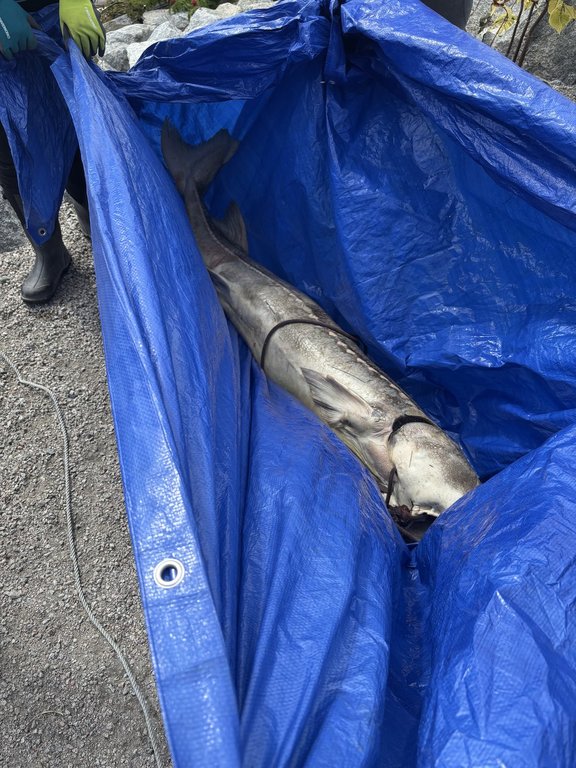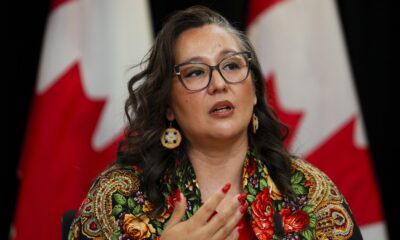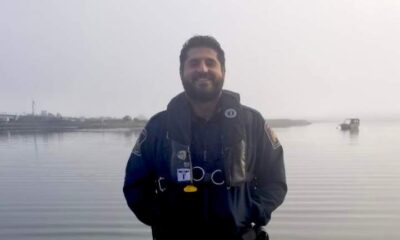Science
Tsawwassen First Nation Launches Study into Sturgeon Mortality

The Tsawwassen First Nation is undertaking an investigation into the recent deaths of sturgeon along the Fraser River in British Columbia. The initiative comes in response to a significant rise in reported mortality events, prompting the First Nation to freeze the carcasses of the fish for research purposes. One sturgeon, measuring approximately 1.6 meters, was retrieved earlier this month and is set to be fitted with an electronic tracker as part of the study.
Concerns Over Increased Mortality Rates
Biologist Kelly Scott, who is leading the research for the Tsawwassen First Nation, expressed deep concern regarding the situation. The sturgeon species, which has existed for around 200 million years, is facing alarming mortality rates. Reports indicate that residents near New Westminster have observed multiple sturgeon floating downstream, with instances of four to six fish spotted in a single day.
According to the British Columbia Ministry of Land, Water and Resource Stewardship, there has been an uptick in sturgeon deaths this year, although the exact extent of the increase is difficult to measure. Since July 2025, the province has documented 71 sturgeon fatalities across British Columbia, with 65 of these in the lower Fraser River. Notably, 49 of these deaths have occurred in just the last four weeks. In contrast, there were only 42 reported deaths in the entire lower Fraser region for 2024.
White sturgeon, among the largest fish species globally, can grow up to six meters long and live for over 100 years. This species holds cultural significance for First Nations, including the Tsawwassen, who have historically harvested them for food and cultural practices.
Factors Contributing to Sturgeon Deaths
The province has prohibited sturgeon harvesting since 1994, and First Nations voluntarily ceased their harvest around the same time. Nevertheless, catch-and-release angling remains permitted in the lower Fraser River. The recent surge in sturgeon fatalities coincides with a rare recreational opening for sockeye salmon in certain areas of the Fraser, raising questions about potential impacts.
Scott highlighted that various factors are likely influencing sturgeon mortality. Climate change is a significant concern, with rising river temperatures intensifying stress on fish populations. “There are not many areas with large, shady trees that can provide thermal refuge for the fish,” Scott explained. Stressed fish caught in gill nets targeting other species face heightened mortality risks. The research team aims to identify cooler habitats for sturgeon and consider restoration efforts in these areas.
Another threat to sturgeon comes from large vessel propeller strikes. One of the recently discovered sturgeon had a severe gash on its back, indicative of such an injury.
The Tsawwassen research team is responding to reports of dead sturgeon and documenting any injuries they observe. Their goal is to collect approximately 20 carcasses, although many have been too decomposed for research. The plan involves drifting carcasses outfitted with telemetry trackers downstream to monitor their movements in various conditions throughout the year.
In collaboration with a researcher from the University of British Columbia, the team is looking into environmental genomics to better understand sturgeon behavior and stress factors in the Fraser River ecosystem.
The provincial statement indicated that multiple factors might contribute to sturgeon mortality, including disease and elevated summer water temperatures. The Fisheries and Oceans Canada has noted that water temperatures in the Fraser River exceeded 20 degrees Celsius during the latter part of the summer, with increased stress for sturgeon at temperatures above 18 degrees Celsius. While increased fishing activity may correlate with the number of reported deaths, the agency has not established direct causation.
Sturgeon populations are protected under federal species-at-risk legislation across much of British Columbia. The upper Fraser, upper Columbia, upper Kootenay, and Nechako River populations have been designated as endangered since 2006. Although the lower Fraser population is assessed as threatened, it has yet to receive specific protection measures. Guidelines for catch-and-release fishing emphasize minimizing impacts on sturgeon, advising anglers to avoid lifting them out of the water to prevent injury.
In 2021, British Columbia initiated a process to develop a comprehensive management plan for white sturgeon in the Fraser River basin, involving collaboration between provincial and First Nations representatives and input from the Fisheries Department. The findings of the Tsawwassen First Nation’s research may be vital in shaping future conservation strategies for this ancient species.
This article originally appeared on September 21, 2025, in The Canadian Press.
-

 Politics4 weeks ago
Politics4 weeks agoSecwepemc First Nation Seeks Aboriginal Title Over Kamloops Area
-

 World5 months ago
World5 months agoScientists Unearth Ancient Antarctic Ice to Unlock Climate Secrets
-

 Entertainment5 months ago
Entertainment5 months agoTrump and McCormick to Announce $70 Billion Energy Investments
-

 Science5 months ago
Science5 months agoFour Astronauts Return to Earth After International Space Station Mission
-

 Lifestyle5 months ago
Lifestyle5 months agoTransLink Launches Food Truck Program to Boost Revenue in Vancouver
-

 Technology3 months ago
Technology3 months agoApple Notes Enhances Functionality with Markdown Support in macOS 26
-

 Lifestyle3 months ago
Lifestyle3 months agoManitoba’s Burger Champion Shines Again Amid Dining Innovations
-

 Top Stories2 months ago
Top Stories2 months agoUrgent Update: Fatal Crash on Highway 99 Claims Life of Pitt Meadows Man
-

 Politics4 months ago
Politics4 months agoUkrainian Tennis Star Elina Svitolina Faces Death Threats Online
-

 Sports5 months ago
Sports5 months agoSearch Underway for Missing Hunter Amid Hokkaido Bear Emergency
-

 Politics5 months ago
Politics5 months agoCarney Engages First Nations Leaders at Development Law Summit
-

 Technology5 months ago
Technology5 months agoFrosthaven Launches Early Access on July 31, 2025





















